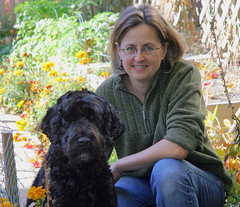

4 Comments
These are my compost bins. The resident carpenter built them for me many years ago. Two side-by-side units with removable fronts. Each year I empty one two-year aged bin-full of compost into the garden. I turn the one-year-old contents of the other bin over into the empty bin so the half-done compost gets mixed and turned over. They work great. This year some potatoes I threw into the front bin are growing a garden of their own. I wonder if I will get new potatoes from them? Solanum tuberosum my…
another Dorothy rose
I know. Enough with the Dorothy’s. But when I see them now, I just can’t help take their picture. Besides, they only bloom for a couple of weeks. Here is a rose that looks to me like a Dorothy (or a Super Dorothy?) along the roadside. I slowed down and the took the picture and the car behind me didn’t seem to mind.
Dorothy Perkins wichuraiana rambler rose (1901)
I have found two other roses around my neighborhood that look like mine. This week it is in its glory. My plant (center, bottom) looks quite neat in comparison with the two others as I just replaced its fence from under it last year. I suspect these are all very old plants. The plants in the two top photos are intertwined with other vines and shrubs. I have not seen another rose that cascades so nicely and has such a relaxed, carefree and graceful appearance.
bee balm blooming
Today the bee balm has begun to bloom. Such an intense color! This is a variety my parents have had for years in their garden. Sometimes bee balm will be pink or magenta – this plant is just solid RED.
Rudbeckia hirta “Prairie Sun”
My green-eyed flowers do look like “Prairie Sun” http://davesgarden.com/pf/go/54909/index.html. After more research, it looks like this is a newer introduction than the old-fashioned ‘Irish Eyes’ http://davesgarden.com/pf/go/49951/index.html. Prairie Sun is the same species as the black-eyed Susan, Rudbeckia hirta, but a different cultivar. It also looks like it will be an annual in my zone (6a). A description I found “The single, daisy flowers are a unique combination of gold and primrose yellow. ‘Prairie Sun’ is the first Rudbeckia with this pattern and a lime green central cone. Slightly later to…
green-eyed Susan?
I should have looked at the label of these flowers before I planted them. I don’t know what they are called. Something new, I guess – I never seen them before. They look very cheerful in the garden. I put them in next to my black-eyed Susan’s, which will not bloom ’til late July or August.
my shady urban garden
Even with all my weather complaints, we have had beautiful weather the past two days. 80’s and partly sunny. I was able to catch up with some gardening. Everything has now been fertilized (with GardenTone and I added a bit of super-phosphate to plants that should bloom or fruit and RoseTone on the roses). I cultivated, mulched (with Very Old Maine whatever-it-is) and supported the tomatoes, cukes, squash and basil. I had to replace a few basil plants that I lost to wet rot. I really like the velcro tomato…
what kind of bee was that?
If you were wondering about the bees on the foxglove I posted on June 21, 2006, so was I. I submitted the photo for identification to BugGuide at http://bugguide.net/node/view/6/bgimage. They identified the bees as Species Anthidium manicatum – Wool Carder Bee (see http://bugguide.net/node/view/59217/bgimage and http://bugguide.net/node/view/7744). It is a fairly uncommon bee that its quite particular about the type of flowers it visits: it loves small-flowered foxglove. It is also very aggressive. It is a non-native European import that is speading through the northeast US. Now we know! garden beesHymenoptera




